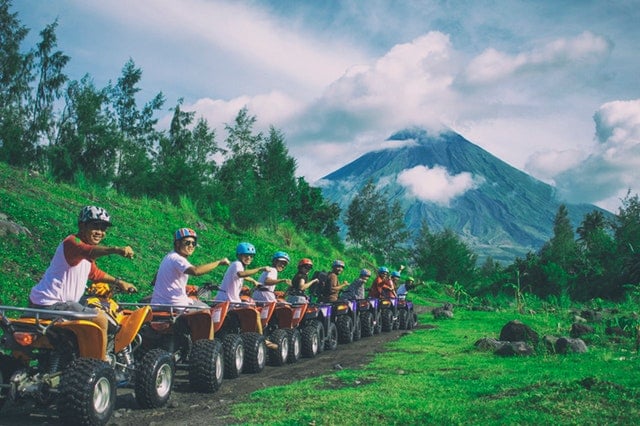ATV Riding Methods: Mastering the Art of Off-Roading

Body Positioning
To effectively navigate with tough off-road terrain, it is vital for ATV riders to consistently maintain appropriate body positioning. Maintaining the correct body setting while riding an ATV not just boosts control and stability yet likewise makes sure the motorcyclist's safety. By embracing the correct body placing methods, bikers can effectively distribute their weight, improve their balance, and reduce the threat of injuries or crashes.
Putting the feet on the foot fixes allows the rider to maintain security and control over the ATV. The rider's knees must be somewhat bent, offering a minor suspension to take in shocks and preserve balance.
In addition, the biker's eyes need to always be concentrated ahead, scanning the terrain and preparing for any obstacles or adjustments in the trail. By keeping a forward stare, bikers can make instant choices and respond properly to challenging terrain.
Throttle Control
Structure upon the value of appropriate body placing for ATV motorcyclists, mastering throttle control is a vital skill that enables riders to successfully maneuver through different off-road surfaces. Throttle control describes the ability to regulate the amount of power provided to the ATV's engine. By comprehending how to manipulate the throttle, bikers can ensure a smooth and controlled velocity, enabling them to browse barriers with precision.
One of the basic facets of throttle control is finding out to regulate the throttle smoothly. Unexpected or jerky motions can trigger the ATV to shed grip or come to be unstable, making it tough to maintain control. Instead, riders must go for gradual and purposeful throttle inputs, particularly when passing through tough terrains. This strategy enables the ATV to preserve a constant rate and supplies far better grip, lowering the danger of accidents.
Along with smooth inflection, cyclists have to also find out how to balance the throttle with various other riding methods, such as body positioning and braking. For instance, when climbing high hills, motorcyclists need to apply adequate throttle to preserve momentum without subduing the ATV or causing wheel spin. In a similar way, when descending steep slopes, bikers need to utilize the throttle in combination with correct body positioning and braking to maintain control and stop the ATV from gliding or toppling.

Braking Techniques
A necessary facet of ATV riding methods is mastering reliable stopping methods. It is vital my review here to keep in mind that extreme braking with only the front brake can cause the ATV to pitch forward, possibly leading to loss of control or also turning over. By understanding these braking techniques, you can enhance your ATV riding abilities and guarantee a delightful and risk-free off-roading experience.
Cornering Methods
One crucial element of mastering ATV riding methods is recognizing efficient cornering strategies. Cornering on an ATV can be challenging, but with the appropriate techniques, cyclists can browse turns safely and efficiently. The trick to effective cornering is to preserve control of the ATV while maximizing traction and lessening the danger of tipping over.
To execute an appropriate cornering method, riders must come close to the turn at an ideal rate, ensuring they are not going too sluggish or as well rapid. It is critical to change the body weight in the direction of the inside of the turn, leaning right into it to keep equilibrium and stability. This aids to counterbalance the centrifugal pressure and keeps the ATV upright.
Additionally, bikers ought to keep their eyes concentrated on the exit factor of the turn instead than the prompt path ahead (ATV). This enables smoother and much more specific guiding, as it helps the rider prepare for any barriers or changes in surface
Additionally, appropriate throttle control plays a substantial role in cornering. Cyclists should regulate the throttle efficiently, avoiding abrupt velocities or slowdowns, which can create loss of control.
Uphill and Downhill Riding
When navigating off-road surface, ATV riders must understand the techniques for uphill and downhill riding to preserve control and ensure safety. Downhill riding, on the various other hand, calls for bikers to lean back and change their weight towards the rear of the ATV. By mastering the methods for uphill and downhill riding, ATV riders can with confidence take on various best site off-road terrains and appreciate a exciting and secure adventure.
Verdict
In verdict, understanding the art more information of ATV riding calls for a mix of body positioning, throttle control, braking methods, and reliable cornering. Uphill and downhill riding additionally call for details abilities to browse securely. By executing these techniques, riders can boost their off-roading experience and boost their overall control and safety and security on the ATV.
ATV Riding Techniques: Grasping the Art of Off-Roading is a comprehensive overview that digs right into the intricacies of understanding the abilities required for off-road ATV riding. Whether you are a newbie or a skilled cyclist, ATV Riding Techniques: Mastering the Art of Off-Roading provides crucial guidance to assist boost your off-road ATV riding skills to the following degree.
